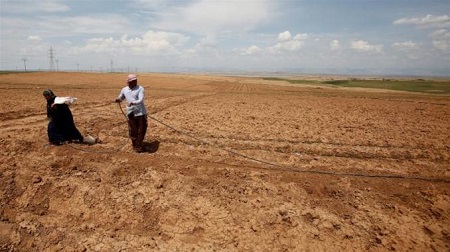Water, Rice and Displacement in Iraq

Iraq is under the influence of the circle of the equator, where high temperature and drought prevail. with a lack of rainfall in the summer. Therefore, agriculture depends primarily on the surface water needed for the stability and sustainability of agriculture, especially in the central and southern of the country.
Iraq is the Arab country most reliant on irrigation. Water resources are an important determinant of agricultural development in Iraq and, therefore, is an important element in the expansion of cultivated areas, the nature and amount of agricultural production, and distribution of population. Iraq has also faced a long and complex problem of water from the Tigris and Euphrates Rivers and their tributaries, as Iraq suffers in the summer and autumn from severe water shortage.
The current water problem is completely different from that of the last century. The quantities of water contained in Iraq has decreased from 79 billion cubic meters per year, 20 years ago, to 15 billion cubic meters per year over the last ten years. Therefore, the trend in agricultural expansion, whether vertically or horizontally, requires the provision of sufficient irrigation water and suitable types of agricultural production.
Meanwhile, the civil and industrial water needs are increasing over time because of the increase in population, as well as the shortage in the water supply of Iraq in the current years. This is expected to continue due to the establishment of dams and related projects in Turkey and Syria, as well as due to climate change. Therefore, Iraq must undertake all means and procedures to ensure optimal use of water and strategies for more efficient use.
Water scarcity is one of the main determinants of agricultural production and its development, especially in arid and semi-arid regions. The agricultural sector is the main consumer of water, especially the rice crop, which is one of the main grain crops in the world, in general, and Iraq, in particular. It comes second after wheat and barley in area and production, because it has a clear place in agricultural production and is characterized by high consumption by citizens in Iraq.
The rice crop is grown in large areas in the traditional irrigation method. It is immersed in the water at a level of 5–10 cm throughout the growth period. However, this method requires large amounts of water, and may reach more than 3,000 cubic meters. The current method of irrigating traditional rice fields is to continue to immerse the soil with water during the crop growth cycle, which requires large amounts of water. These quantities estimated about 70,000 m3 / ha for the length of the growing season, according to the Japanese expert Kasumi Ito, who visited Iraq in 1963.
The method of immersion or continuous irrigation of the fields adversely affect the environment, because it contributes to the massive dumping of chemicals such as fertilizers and pesticides that cause pollution of both water and soil. The difficulty to provide large quantities of water during the rice-growing season in the summer leads to great fluctuation of cultivated areas from one year to the next. These challenges require new thinking and research strategies to change the traditional methods in rice cultivation.
In recent years, the level of monsoon rains has declined such that reliance on irrigation from rivers remains the most important factor in the success of rice cultivation in Iraq. This forms a weak point in the food security of the country.
In 2018, farmers were prohibited from growing rice and other crops due to drought and reduced freshwater flows to rivers and tributaries. Many farmers then migrated to nearby cities or emigrated entirely to seek non-agricultural livelihoods.
People displaced from their homes while remaining within the borders of their country and the proportion of displacement varied from one agricultural area to another. However, the displacement rates were estimated between 40-70%. The number of families undertaking rice cultivation in Iraq totals some 100 thousand families. Many of them have become a factor in the large number of 70 thousand families added to the ranks of the unemployed in the cities.
Photo on the front page: An Iraqi farmer plants Jasmin rice in the Mishkhab region, central Iraq, some twenty-five kilometers from Najaf, 6 June 2018. Iraq’s treasured amber rice crop devastated by drought. Source: AFP. Photo on this page: With one in five Iraqis working as farmers, crippling water shortages have pushed many to find alternative employment. Source: Eplanetnews.com.
|